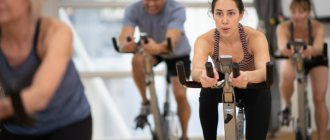Many people plan to exercise actively and wonder how often they should exercise. How much time to spend on training, how to eat properly and recover, says Yulia Dzhusupova, a trainer at the REBOOT sports studio network.
shutterstock.com
The frequency of classes directly depends on the type of training. Daily exercise is dangerous if it is a hard, exhausting workout. During strength training, a person’s immune, endocrine and nervous systems are actively loaded. The body spends a lot of effort and energy on their restoration: you get tired, feel weak, physical performance drops, your mood worsens, and chronic drowsiness appears. As a result, the training process stops and health problems appear.
shutterstock.com
If we talk about fitness, it is recommended to train three days a week. This is due to the fact that the muscular system recovers much faster. For those who want to train every day, it is necessary to competently build a training plan: alternate classes according to the degree of load. For example, three main workouts and between them a toning load for the whole body: 20-30 minutes of non-high-intensity training.
Every day you can do stretching, observing the dosed load.
Content
- 1 About the benefits of strength training 1.1 1. You will burn 40 percent more fat
- 1.2 2. You will burn more calories
- 1.3 3. Clothes will fit you better
- 1.4 4. You can prolong the youth of your body
- 1.5 5. Increase Bone Density
- 1.6 6. You will become more flexible
- 1.7 7. Strengthen your cardiovascular system
- 1.8 8. You will defeat diabetes
- 1.9 9. You will reduce your risk of cancer
- 1.10 10. It will be easier for you to stick to your diet
- 1.11 11. You will be able to cope with stress better
- 1.12 12. You will be better able to cope with jet lag.
- 1.13 13. Your mood will improve
- 1.14 14. You will sleep better
- 1.15 15. You will get fit faster
- 1.16 16. You will overcome depression
- 1.17 17. You will be more productive
- 1.18 18. You will live longer
- 1.19 19. You will save the memory
- 1.20 20. You will become smarter
Home workouts: pros and cons
Working out at home is much more convenient than in the gym. Exercising at home saves time and allows you not to depend on the schedule of classes at the fitness club. Home workouts have many advantages:
- budget. You do not need to purchase a subscription or pay for a consultation with a trainer. If you want to practice according to someone else’s original program, then you will need to purchase a set of workouts. But this is not necessary, because there are many home fitness programs available on the Internet;
- saving time. On average, it takes 1-2 hours to travel to the sports club and home, change clothes and shower. With a busy daily schedule, it can be difficult to find them. By studying at home, you save this time for more important things;
- lack of a clear schedule. You can conduct home workouts at a time convenient for you;
- psychological comfort. Many people are embarrassed by their poor physical fitness, which creates some inconvenience during exercise in the gym. At home you feel comfortable.
But training at home is not as easy as it might seem at first glance. Here you feel relaxed, and therefore you need enormous self-discipline to play sports. At home, you will have to find your own motivation and control the training process. In addition, the home is full of distractions. Housework, an unexpected call from a friend, a child demanding attention - all this disrupts the work rhythm.
A significant disadvantage of home training is the lack of equipment and sports equipment. If dumbbells can still be purchased, then you are unlikely to install the exercise machine at home. Over time, there will be a need to increase physical stress on the muscles, and this will require heavier equipment. There will also be no trainer at home to help you adjust your training program and ensure that the exercises are performed correctly.
About the benefits of strength exercises[edit | edit code]
The Benefits of Exercise
20 Ways Strength Exercise and Training Help You Look Great, Stay Healthy, and Live Longer.
“You don’t look like you’re doing any strength training” is a phrase I’ve heard more than once, and it’s usually said by a burly guy in a sleeveless T-shirt, whose appearance leaves no doubt that he’s probably been doing some strength training. . And his assessment was undoubtedly based on the standards of a typical bodybuilder.
Frankly, I never aspired to become a bodybuilder, a powerlifter, or a strongman competitor. (Although, of course, all this is not bad.) Why then should I look like a bodybuilder? Of course I look different.
But do I look like someone who does strength training? Without a doubt. I am slim, have good physical shape, I have beautiful muscle definition, although my muscles are not nearly as voluminous as those of professional bodybuilders.
The fact is that strength training should not be associated solely with the desire to have huge biceps. What's more, for many of us, motivation can be very different, since the benefits we get from strength training touches almost every aspect of our health and well-being. After 12 years of research into health and fitness, I've come to one undeniable conclusion: You'd be stupid not to do strength training—even if you don't care about how big your biceps are.
Strength training helps combat belly fat, stress, cardiovascular disease, diabetes and cancer, and improves mood and mental processes. How can something as simple as repeatedly lifting and lowering a weight produce so much benefit? The beneficial effect begins at the micro level of muscle fibers.
Let's start with the basics
: When you perform strength exercises, micro-tears of muscle fibers occur. This helps accelerate muscle protein synthesis, during which muscle fibers are restored and strengthened using amino acids, which ultimately increases muscle resistance to progressive stress. Thus, if muscle fibers are exposed to frequent stress (as is the case with regular strength training), they undergo structural adaptations that allow them to better tolerate the load in the future. Thus, the muscles adapt, increasing in volume, increasing strength and becoming more resilient.
Purpose of this process
- Reducing the stress on the body, as a result of which you are able to perform everyday activities such as climbing stairs and holding a light object without much effort. This also explains why even the most strenuous physical activities become easier over time if you do regular strength training. This phenomenon is called the training effect. But, as it turns out, this effect improves not only the condition of your muscles, but also the quality of your entire life.
Do you need proof? Below you will find 20 reasons why you should never go a day without strength training.
1. You'll burn 40 percent more fat[edit | edit code]
This may be the biggest secret to successful weight loss. And while you've no doubt been told more than once that aerobic exercise is the key to effectively burning body fat, the reality is that strength training is more suitable for this purpose.
Example to prove it
: Scientists from Pennsylvania State University suggested a low-calorie diet for overweight people. The experiment participants were divided into three groups. The first did not exercise, the second did aerobic exercise three times a week, and the third did aerobic and strength exercise three times a week. Participants in all three groups lost about 10 kilograms, but in the third group, people lost 3 kilograms more fat than in the first two. Why? Because in the third group, weight loss occurred exclusively due to fat, and in the first two groups, participants burned approximately 7 kilograms of body fat and lost 3 kilograms of muscle mass. Do the math and see that the participants who did the strength exercises burned 40 percent more fat.
And this is not the only study on this issue. Observations of people who diet but do not engage in strength training show that on average 75 percent of weight loss comes from fat and 25 percent from muscle. This 25 percent, of course, affects the overall reduction in body weight, but does not improve your reflection in the mirror. What's more, they make it more likely that you'll regain the fat you worked so hard to burn off. However, if you supplement your diet with strength training, you will burn more fat without losing an ounce of muscle.
Approach this issue like liposuction. Your task is to get rid of unattractive fat. This is exactly what you will get as a result of training.
2. You will burn more calories[edit | edit code]
Strength training can help you burn more calories, even if you're just sitting on the couch. One of the reasons for this phenomenon is that after each workout, your muscles need energy to restore and repair muscle fibers. Thus, scientists from the University of Wisconsin found that after training, including only three exercises for large muscles, the metabolism of the experiment participants remained elevated for the next 39 hours. Those who did strength training also burned more fat than those who didn't.
What happens during training? Many experts say that running at a moderate pace burns more calories than strength training. But it turns out that in reality this is not the case. Scientists at the University of Southern Maine, using a sophisticated technique to measure energy expenditure, found that strength training burns 71 percent more calories than previously thought. Experts have calculated that performing just one cycle of eight strength exercises allows you to burn from 159 to 231 kilocalories. You can burn this amount of calories if you run at a speed of 15 kilometers per hour for the same time.
3. Clothes will fit you better[edit | edit code]
If you don't do strength training, you can say goodbye to your biceps. Research shows that between the ages of 30 and 50, a man loses up to 10 percent of his muscle mass. And by the age of 60, this figure will probably double.
What's more, as reported in the American Journal of Clinical Nutrition, lost muscle is replaced by fat over time. Scientists found that even those who managed to keep their total body weight the same until age 38 lost about 1.5 kilograms of muscle mass and gained 1.5 kilograms of fat every ten years. And this leads not only to the fact that your body becomes loose and unathletic, but also to the fact that your waist circumference increases, since a kilogram of fat takes up 18 percent more volume than a kilogram of muscle. Fortunately, this process can be prevented with regular strength training.
4. You can prolong the youth of your body[edit | edit code]
It's not just the amount of muscle mass you lose that matters, but also its quality. Research shows that the number of fast muscle fibers decreases by 50 percent with age, while the number of slow muscle fibers decreases by only 25 percent. Fast-twitch fibers are primarily responsible for muscle strength and also provide movement power, which depends on a combination of strength and speed. Movement power is a key factor in ensuring high results in any sport, but in addition, it is also important in everyday life. Have you noticed that older people often have difficulty getting up from a chair? The reason for this phenomenon is the atrophy of the fast muscles as a consequence of the fact that they are not subjected to excessive load. In 2015, a study by specialists from King's College London was published which claims that cycling slows down the aging process.[1]
Do you want to know the secret that will allow you to turn back time? Do strength training. Particularly effective in this sense is performing exercises at a high pace with light weights. (If in this book you come across the expressions “explosive push-ups,” “explosively throw your body to the right and up,” “powerfully lift the dumbbell to your shoulder,” and the like), know that they are ideal for training fast-twitch muscle fibers.
In 2021, scientists at the University of Birmingham published a study[2], according to which cycling significantly slows down aging and allows older people to maintain biological indicators at the level of young people.
5. Increase bone density[edit | edit code]
As you age, you also lose bone mass, which increases the likelihood of bone fractures. Scientists from the Mayo Clinic found that 30 percent of men who suffer a hip fracture never get back on their feet. In addition, significant loss of bone mass in the spine can lead to the formation of a hump. However, there is good news: a study published in the Journal of Applied Physiology shows that after 16 weeks of strength training, bone density increased by 19 percent. At the same time, an increase in the blood level of osteocalcin, a marker of bone formation, is also observed.
6. You will become more flexible[edit | edit code]
With age, flexibility can decrease by half. You will have difficulty squatting, bending and turning. However, there is good news: research results published in the International Journal of Sports Medicine show that training three times a week for all muscle groups for four months increased the flexibility of the hip and shoulder joints by 11 percent. Do you think that strength training leads to muscle tightness? Research shows that Olympic weightlifters are second only to gymnasts in overall flexibility.
7. Strengthen your cardiovascular system[edit | edit code]
Strength training increases blood circulation. Scientists from Michigan State University found that people who did three workouts per week for all muscle groups had their diastolic blood pressure drop by 8 points over two months. This is enough to reduce the likelihood of a stroke by 40% and a heart attack by 15%. In another study published in September 2014 in the journal American College of Sports, Medicine, a group of scientists stated that lack of physical activity for 5 days leads to damage to the vascular endothelium.[3][4]
8. You will defeat diabetes[edit | edit code]
You can think of strength training as muscle medicine. In a 4-month study, Austrian scientists found that people with type II diabetes experienced a significant reduction in blood sugar levels as a result of strength training, which improved their condition. It is also important that strength exercises can prevent the development of diabetes, not only by helping to fight fat, which increases the likelihood of developing this disease, but also by increasing the body's sensitivity to insulin. This helps keep blood sugar levels under control, thereby reducing the likelihood of developing diabetes.
9. You will reduce your risk of developing cancer[edit | edit code]
But this is not all the benefits that strength exercises will bring to your health. Scientists from Florida State University found that people who did three strength training sessions per week for 6 months had a significant reduction in oxidative stress (the process of cell damage due to oxidation). This fact is very important, since cell damage can lead to cancer and other diseases. The study, published in the journal Medicine and Science in Sports and Exercise, found that strength training increased the rate at which food passes through the colon by 56%, which scientists say may reduce the risk of colon cancer. Another study[5], conducted by a group of researchers from the University of Sydney in Australia, showed that regular strength exercise reduces the risk of death from all causes by almost a quarter, and mortality from cancer by 31%.
A study conducted by a group of scientists from Copenhagen[6] demonstrated a molecular link between physical activity and cancer prevention. The benefits of exercise for cancer patients are becoming increasingly clear. Exercise has been shown to reduce the incidence of cancer and inhibit tumor growth. Scientists suggest that exercise plays a role in combating cancer progression by directly influencing intrinsic tumor-related factors and interacting with whole-body effects to alleviate cancer-related side effects and improve the effectiveness of cancer treatments. These findings have wide-ranging societal implications, as this understanding may lead to changes in cancer treatment strategies.
10. It will be easier for you to stick to your diet[edit | edit code]
When it comes to weight loss, the benefits of strength training are twofold: you not only burn calories; It becomes much easier for you to stick to your diet. Scientists at the University of Pittsburgh followed a group of 169 overweight people for two years and found that participants who did not exercise three hours a week consumed more than their 1,500-kilocalorie limit per day. The opposite trend was also observed: those who break their diet also miss training. Researchers believe that diet combined with strength training strengthens your resolve to stay the course and move toward your weight loss goal.
11. You will be able to cope with stress better[edit | edit code]
Sweat in the gym and you'll be able to stay calm under stressful circumstances. Scientists from the University of Texas have concluded that people who are in good physical shape have lower levels of stress hormones. A study conducted by scientists from the Medical College of Georgia found that the rate at which blood pressure normalizes after a stressful situation depends on the amount of muscle mass: the more muscle mass, the faster blood pressure returns to normal. Exercise and physical training have a positive effect on a person’s ability to deal with stress[7], acting as a buffer. So stressful events have less negative effects on psychological and physical health.
12. You will be better able to cope with jet lag[edit | edit code]
Next time you have to fly across the ocean, before you unpack your bags, hit the hotel gym. Scientists from Northwestern University and the University of California found that after strength training, changes in protein synthesis and activity occur that are characteristic of certain times of day. As a result, they came to the conclusion that strength exercises help the body adapt more quickly to jet lag and work shifts.
13. Improved mood[edit | edit code]
Yoga isn't the only type of exercise that can help you calm down. Scientists from the University of Alabama at Birmingham found that people who did strength exercises three times a week for 6 months felt significantly calmer and their mood improved.
English scientists conducted an experiment in which more than 10,000 people took part. The scientists used a specialized mobile application that reflected a person’s physical activity in relation to his emotional state. As a result, it has been demonstrated that physical activity has a positive effect on a person's psychological health.[8]
14. You'll sleep better[edit | edit code]
Intense strength training will help you fall asleep easier and sleep better. Australian scientists observed that patients who did strength exercises for all muscle groups three times a week for eight weeks had a 23 percent improvement in sleep quality. Moreover, the experiment participants fell asleep faster and slept longer than before the start of the training.
15. You will get into good physical shape faster[edit | edit code]
It's not just aerobic exercise that strengthens the cardiovascular system. A study from the University of Hawaii found that resistance cycling increased heart rate 15 beats per minute more than running, which kept the heart rate at 60 to 70 percent of maximum. This method not only strengthens muscles, but, like aerobic exercise, improves the condition of the cardiovascular system. So, you can save time without losing anything.
16. You will overcome depression[edit | edit code]
Don't take antidepressants. Do better strength training. Scientists from the University of Sydney found that regular strength training significantly alleviates the main symptoms of depression. The researchers reported that significant improvement was observed in 60 percent of cases of clinically diagnosed depression—comparable to antidepressant treatment without the negative side effects. Another study published in the American Journal of Psychiatry[9] found that an hour of moderate physical activity per week was enough to reduce the risk of symptoms of clinical depression by 12 percent.
New Zealand scientists from the University of Auckland conducted a study in which they proved that physically active children tend to have fewer symptoms of depression than their less active peers. The higher the levels of moderate- and vigorous-intensity physical activity in children aged 6 and 8 years, the fewer symptoms of depression the children had 2 years later. Levels of depression decreased with each additional hour of physical activity.[10]
17. You will be able to work more productively[edit | edit code]
Buy dumbbells and they will help you get an increase in your salary. Scientists from the UK found that on days when workers exercised, their productivity increased by 15 percent. Consider what these numbers could mean for you: On training days, you can (in theory, anyway) complete a volume of work in 8 hours that would otherwise take you 9 hours and 12 minutes. Or you could work the same 9 hours, but be less tired and enjoy your work more—another benefit workers reported when talking about their workout days.
18. You will live longer[edit | edit code]
Strength training will help you live longer. Scientists from the University of South Carolina have determined that high-quality strength training is associated with a reduced risk of death from cancer, heart disease and other diseases. Similarly, scientists from the University of Hawaii found that maintaining strength qualities allows you to live up to 85 years in the absence of serious diseases. Even moving around every half hour can help limit the impact of a sedentary lifestyle[11]. However, exercise is not enough to prevent the risks of sitting for long periods of time; regular movement is necessary.
19. You will preserve the memory[edit | edit code]
You should never forget how important strength training is. Scientists from the University of Virginia found that men and women who did strength exercises three times a week for 11 months saw significant reductions in homocysteine levels, which are associated with the development of dementia and Alzheimer's disease.
20. You will become smarter[edit | edit code]
Speaking about the connection between muscles and brain, it is worth mentioning a study conducted by Brazilian scientists. They found that 6 months of strength training significantly improved the mental abilities of the experiment participants. Training improves short- and long-term memory, verbal reasoning, and attention span.
Without this, it is useless to go to the gym: what should you take with you?
The comfort, convenience and feeling of confidence of girls in the gym also depend on what they are wearing. Before you go there, don’t forget about your faithful helpers – accessories. A forgotten towel or water has ruined more than one workout.
I have compiled for you a list of the most necessary things in the gym, based on my own many years of experience in the gym, and also asked for the opinions of several familiar fitness instructors. On the path to sports victories, clothing and footwear can make a significant contribution to your success.
Sports bra
What is a fitness bra or top for? Everything is simple here. To maintain breast shape as the rest of the body begins to gain muscle mass and burn fat tissue, girls need to purchase one more item of clothing than guys. All women should take care of the health of their mammary glands, regardless of their shape. Sports bras are divided into several types:
- Light support. Sconces of this shape are designed for calm walking or yoga.
- Average support. In this top, even the most curvy figures will look more modest, however, you can safely dance and do cardio in it.
- High support. Maximum cup support is ideal for running, intense training and strength training in the gym.
The function of bras for girls is simple - in the right underwear, your breasts should not “jump”. It will be better if you don’t go to the gym in your usual bra, and when choosing a bra, give preference to comfort rather than appearance.
Sneakers
Shoes, girls, are your foundation and what you will see before your eyes 50% of the time when exercising in the gym. Therefore, it is so important for beginning athletes to choose comfortable and beautiful shoes for the gym. To improve your exercise technique and minimize the risk of injury, focus on the following options:
- Sneakers for strength sports. You won't need them if you evenly distribute the load in the gym and don't approach dumbbells heavier than 10 kg. But those who are going to seriously engage in extreme strength training, bodybuilding and powerlifting will need so-called weightlifters. These shoes have a firm, high and rigid sole; they fit snugly to the foot and do not slip. If you want to squat heavy with a barbell, a high heel will help correct the incorrect torso tilt during the exercise. Famous models: Adidas AdiPower, Nice Romaleos. As a beginner, you should also try minimalist sneakers. This stretchy and flexible shoe will allow you to have full control of your foot movements and provide the most stable base for your squats. A good example is the Nike Free Hyperfeel.
- For fitness. When going to fitness, you need to wear shoes that are capable of ensuring lightness, shock absorption and air permeability of the foot during jumping, rapid physical activity, and aerobic exercise. Sneakers with a mesh surface and a cushioned insole, such as the Ryka Vida and Ryka Influence, are great for your fitness routine.
- Cross training. This type of sneaker should not be confused with weightlifting shoes or lighter fitness shoes. The soles are firm enough to provide stability, but at the same time they allow you to run and jump in them due to their flexibility. Reebok Crossfit Nano is popular.
Research on the health benefits of exercise[edit | edit code]
- Physical exercise reduces the risk of breast cancer[12][13]
- Exercise reduces the risk of heart failure[14]
- Physical activity has a beneficial effect on overall health and slows down the aging process[15]
- Aerobic exercise improves mental performance and protects against dementia in old age[16]
- Exercise prevents heart rhythm disturbances in women after menopause[17]
- Regular exercise prevents depression[18], and also has a positive effect on “psychological well-being”, cognitive abilities and reduces the risk of developing age-related diseases.[19]
- Physical training (30 minutes of running), 4 hours after training, improves long-term memory.[20]
- For people with a sedentary lifestyle, an hour of moderate exercise per day is enough to reduce the risk of premature death.[21]
- When performing regular strength training, 3-4 times a week, men with a sedentary lifestyle improve the quality of sperm: volume, quantity and motility of sperm.
- Low physical activity among boys leads to lower school performance.[22]
Working out in the gym: advantages and disadvantages
The peculiarity of training in the gym is that the very atmosphere of this place puts you in a working mood. Here you are surrounded by people whose goals often coincide with yours. For many beginners, this becomes the strongest motivation to work productively on themselves. When you see the results of others, the desire to achieve it yourself appears.
Working out in the gym is also convenient because it has all the necessary equipment. This allows you to work on all muscle groups, not limited to the main zones. Using equipment also allows you to increase the load, which makes training more effective.
Beginners often need the help of a trainer who will help create a training program and show the technique of doing the exercises. It is best to take individual lessons with a trainer at first until you get comfortable in the gym and learn how to perform the exercises correctly. Later you can study on your own.
If you get tired of working out on exercise machines, you can always go to group classes. In most sports clubs you can sign up for Pilates, aerobics, cycling and other types of fitness.
However, working out at the gym also has some disadvantages that may affect your decision to purchase a membership:
- high cost of going to the gym. On the one hand, this is a disadvantage, but on the other hand, it is an additional motivation not to miss training;
- having to get to the gym. Sometimes, due to the inconvenient location of the sports club, the journey to and from training can take too much time;
- adherence to a training schedule. You often have to rearrange your daily routine so that you can get to the gym at a convenient time.
The benefits of strength training for girls[edit | edit code]
Strength training benefits all women. Young people can use them to make their figure attractive. Female athletes will develop strength and endurance. Women who lead an active lifestyle will improve their physical fitness. Strength training will help all women prevent the development of cardiovascular diseases, fight stress and excess weight. In addition, they are an effective tool for restoring your figure after childbirth.
For middle-aged women, exercise can help combat health problems associated with menopause and maintain the integrity of bones and muscles. Performing strength exercises prevents the formation of fat deposits in the abdominal area and sagging skin.
For older women, weight training will help prevent loss of joint mobility and strengthen muscles and bones, thereby slowing down the aging process.
Of course, the importance of strength training goes beyond visual attractiveness. They prolong life and improve its quality. After all, health is not a gift from heaven. While genetics do play a significant role in maintaining health, scientific research shows that genetics only accounts for 30 percent of overall health. The remaining 70 percent is determined by lifestyle. In other words, we are responsible for our health.
A lack of physical activity is associated with a significant reduction in life expectancy. Thus, every hour spent without movement reduces life expectancy by 21 minutes.
Large-scale studies show that people who lead a generally inactive lifestyle but exercise for 15 minutes a day have a three-year increase in life expectancy compared to those who do no exercise. Strength training and cardio exercises (running, cycling, aerobics) effectively counteract the harmful effects of a passive lifestyle.
Weight training involves applying stress to muscles, tendons, ligaments and joints. If the exercises are performed correctly, the load has a strengthening effect, but if not, then you can get injured. Strength training should be a healthy habit, not a health hazard. Therefore, this book places great emphasis on injury prevention. Her goal is to create a strong and beautiful body, not destroy it.
The article Gym Workout Program for Girls provides a comprehensive guide to creating a customized workout program that suits your goals and capabilities. Part II details the best exercises for each area of the body. Complete training programs are presented in Part III.
Cardio (aerobic) and weight training will not only make you look attractive, but will also improve your health.
Class Rules
When conducting classes in the gym, you must adhere to certain rules. Training is carried out in three stages:
- warm-up;
- main part;
- hitch.
None of these stages can be neglected. Otherwise, the effectiveness of your training will decrease and your health may be harmed.
Warm-up
Before you begin performing a set of exercises on the machines, you must warm up your muscle tissue. It is for this purpose that warm-up is carried out. It lasts at least a quarter of an hour. It includes five minutes of cardio. This could be running or riding an exercise bike. The rest of the time is spent doing bodyweight exercises and stretching.
If you start training without warming up, the risk of injury and discomfort increases.
A 15-minute cardio workout is a great warm-up before exercise.
Main part
Beginners working out at the gym need to create a workout plan in such a way that the load is applied to the whole body. It is extremely important to practice the technique of performing the exercises and remember it. In addition, the reaction of muscle tissue to the applied load is analyzed. It is possible that a certain muscle group will be more resilient.
The exercises are performed according to a certain principle. Initially the hips are worked out. Then the load goes to the chest and back. After this, they develop the shoulders and arms. The workout ends with working out the abs. Adhering to this scheme, you need to choose the most suitable exercise equipment from those in the gym.
Before starting training in the gym, it is important to correctly draw up a program that will include exercises to work all muscle groups.
Typically, training is carried out according to the following scheme: hips - back - arms - abs
Completing the workout
The load should be reduced gradually. It is recommended to jog or walk on a treadmill, or pedal a little on an exercise bike. Recovery should take at least 10 minutes.
Cooling down is the opposite of warming up. During the lesson, my heart worked hard and pumped blood intensively. Accordingly, its activities need to be stabilized. If you stop training quickly, blood will begin to flow intensively to the head and internal organs. Headache, dizziness and nausea will occur.
Cooling down is an essential part of any workout.
Sources[edit | edit code]
- https://www.kcl.ac.uk/newsevents/news/newsrecords/2015/January/Exercise-allows-you-to-age-optimally.aspx
- https://onlinelibrary.wiley.com/doi/full/10.1111/acel.12750
- https://medicine.missouri.edu/news/0252.php
- https://journals.lww.com/acsm-msse/pages/articleviewer.aspx?year=9000&issue=00000&article=97921&type=abstract
- https://sydney.edu.au/news-opinion/news/2017/11/01/strength-exercise-as-vital-as-aerobic-new-research-finds.html
- https://www.cell.com/cell-metabolism/fulltext/S1550-4131%2817%2930567-3#
- https://journals.plos.org/plosone/article?id=10.1371/journal.pone.0169746
- https://www.cam.ac.uk/research/news/physical-activity-even-in-small-amounts-benefits-both-physical-and-psychological-well-being
- https://newsroom.unsw.edu.au/news/health/one-hour-exercise-week-can-prevent-depression
- https://eurekalert.org/pub_releases/2017-01/nuos-pac013017.php
- https://www.theguardian.com/society/2017/sep/11/moving-every-half-hour-could-help-limit-effects-of-sedentary-lifestyle-says-study
- L. Rosenberg, J. R. Palmer, T. N. Bethea, Y. Ban, K. Kipping-Ruane, L. L. Adams-Campbell. A prospective study of physical activity and breast cancer incidence in African American women. Cancer Epidemiology Biomarkers & Prevention, 2014;
- A. Fournier, G. Dos Santos, G. Guillas, J. Bertsch, M. Duclos, M.-C. Boutron-Ruault, F. Clavel-Chapelon, S. Mesrine. Recent Recreational Physical Activity and Breast Cancer Risk in Postmenopausal Women in the E3N Cohort. Cancer Epidemiology Biomarkers & Prevention, 2014;
- Kasper Andersen, Daniela Mariosa, Hans-Olov Adami, Claes Held, Erik Ingelsson, Ylva Trolle Lagerros, Olof Nyren, Weimin Ye, Rino Bellocco, and Johan Sundström. Dose-Response Relations of Total and Leisure-Time Physical Activity to Risk of Heart Failure: A Prospective Cohort Study. Circulation: Heart Failure, August 2014
- BG Vopat, SA Klinge, PK McClure, PD Fadale. The Effects of Fitness on the Aging Process. Journal of the American Academy of Orthopedic Surgeons, 2014; 22(9):576
- C. J. Gauthier, M. Lefort, S. Mekary, L. Desjardins-Crépeau, A. Skimminge, P. Iversen, C. Madjar, M. Desjardins, F. Lesage, E. Garde, F. Frouin, L. Bherer, R.D. Hoge. Hearts and minds: linking vascular rigidity and aerobic fitness with cognitive aging. Neurobiology of Aging, 2014;
- Farnaz Azarbal, Marcia L. Stefanick, Elena Salmoirago-blotcher, Joann E. Manson, Christine M. Albert, Michael J. Lamonte, Joseph C. Larson, Wenjun Li, Lisa W. Martin, Rami Nassir, Lorena Garcia, Themistocles L. Assimes, Katie M. Tharp, Mark A. Hlatky, and Marco V. Perez. Obesity, Physical Activity, and Their Interaction in Incident Atrial Fibrillation in Postmenopausal Women. JAHA, August 2014
- American Psychological Association (APA). "Physical fitness can help prevent young adolescents' depression, study finds." ScienceDaily. ScienceDaily, 7 August 2014.
- https://link.springer.com/article/10.1007%2Fs12160-016-9856-y
- https://www.sci-news.com/othersciences/physiology/physical-exercise-long-term-memory-03959.html
- https://www.wonderzine.com/wonderzine/health/health-news/219863-go-jogging
- https://www.jsams.org/article/S1440-2440(16)30238-9/abstract











